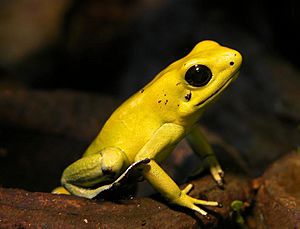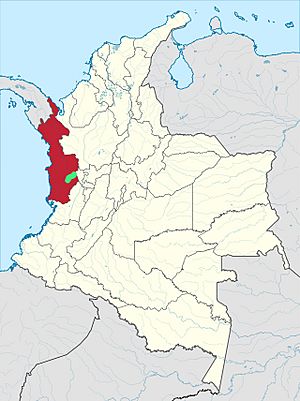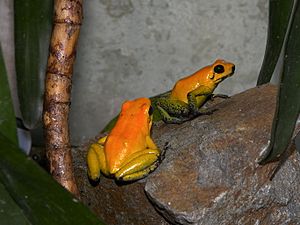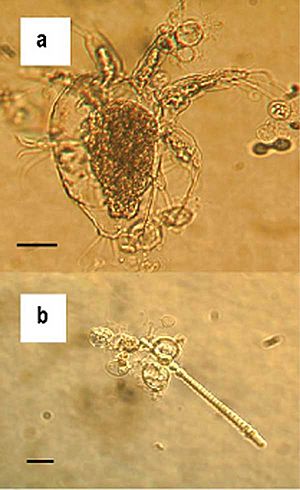Phyllobates bicolor facts for kids
Quick facts for kids Phyllobates bicolor |
|
|---|---|
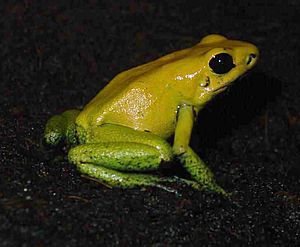 |
|
| Conservation status | |
| Scientific classification |
The Phyllobates bicolor, also known as the Black-legged poison dart frog, is one of the most poisonous frogs in the world. It is the second most toxic dart frog. This frog belongs to the Phyllobates group. People sometimes confuse it with the golden poison frog (Phyllobates terribilis) because they look very similar.
You can tell the Black-legged poison dart frog apart by its bright yellow or orange body. Its front and back legs are black or dark blue, which is how it got its name. These frogs live in the tropical rainforests of the Chocó region in Colombia. They are active during the day and can be found on the rainforest floor near streams or puddles.
Like other Phyllobates species, the Black-legged poison dart frog produces a powerful poison called batrachotoxin. This toxin affects how cells work in the body. Because of this deadly poison, some native groups in Colombia have used it to make poison-tipped darts for hunting. During breeding season, male frogs make high-pitched calls to attract females. The father frog often carries the tadpoles on his back to a safe place for them to grow.
Sadly, the Black-legged poison dart frog is an endangered species. Its biggest threats are deforestation, loss of its home, and pollution. Some groups, like the Baltimore National Aquarium and Tatamá National Natural Park in Colombia, are working to save these frogs through programs like captive breeding.
Contents
About the Black-legged Poison Dart Frog
What Does it Look Like?
The Black-legged poison dart frog is one of the largest poison dart frogs. Male and female frogs are almost the same size. Males grow to be about 4.5 to 5 centimeters long. Females are a little bigger, reaching 5 to 5.5 centimeters.
These frogs can be orange or bright yellow. Their legs often have a blue or black color, which gives them their name. These bright colors are a warning sign to animals that might want to eat them. It tells predators, "I am poisonous, stay away!" Bright colors can also help males attract females during mating season. A male with brighter colors might be more attractive to a female.
The Black-legged poison dart frog is smaller and less poisonous than its close relative, the Phyllobates terribilis. Young P. terribilis frogs can also look like P. bicolor. This can sometimes make it hard for scientists to tell them apart. Like other amphibians, these frogs change as they grow. Young frogs are brown or black, but they become brighter in color as they get older.
Where Do They Live?
Phyllobates frogs live in a unique way across the western South American coast. They show a "leapfrog" pattern. This means that groups of similar-looking frogs are separated by other groups that look different.
The Black-legged poison dart frog is one of five frog species found between Nicaragua and Colombia. It is usually separated from other frog species, except for P. terribilis. High mountains and a river basin make it hard for these frog groups to mix. This "leapfrogging" pattern shows that each group of frogs has developed unique features over time.
How Toxic Are They?
The Batrachotoxin Poison
While not as strong as the P. terribilis poison, the Black-legged poison dart frog is still very toxic. It is one of the few frogs known to have caused human deaths. In their natural home, these frogs release poison from tiny pores in their skin. The frogs do not make the poison themselves. Instead, they get the chemicals needed for the poison from the insects they eat.
Just a tiny amount of their poison, called batrachotoxin (BTX), can be deadly to a human. Scientists are studying BTX to see if it could be used for medicine. This poison works by affecting special channels in your body's cells. When BTX touches these channels, it locks them open. This stops nerves from sending signals, which can cause muscles to stop working, heart failure, and breathing problems. There is no known cure for BTX poisoning.
The frogs themselves are not harmed by their own poison. Scientists believe the amount of poison on their skin is not enough to hurt them. Also, it seems that frogs can inherit a way to be immune to the poison.
Poison Darts for Hunting
The poisons from P. bicolor, P. terribilis, and Phyllobates aurotaenia are often used by people to make poison-tipped darts. The Chocó people in Colombia mainly use these darts with blowguns to hunt animals. Other tribes use plant-based poisons, but the Chocó are unique in using poisons from Phyllobates frogs.
The Chocó people use two main ways to get the poison. For P. terribilis, they rub the dart tips directly on the skin of a live frog. For P. bicolor and P. aurotaenia, they gently skewer the frog with a stick and hold it over a fire. This makes the frog release its toxins, and then the dart tips are rubbed on the liquid. The method used depends on how much poison each frog species produces. P. terribilis has a stronger poison, so a different method is used.
Behavior and Life Cycle
Daily Life
Black-legged poison dart frogs are active during the day. This is different from most frogs, which are active at night. Being active during the day means their bright warning colors can be seen better by predators.
During the day, these frogs move quickly across the rainforest floor. They are carnivores, meaning they eat meat. They hunt for ants, beetles, termites, and other small insects. Some of these frogs live alone until it's time to mate. However, sometimes small groups of P. bicolor can be seen together. They like damp, humid places like rocks, moss, and fallen branches. At night, they often gather under leaf litter.
Reproduction and Parental Care
The Black-legged poison dart frog starts to reproduce during the wet season, usually in September and October. A male frog will make a buzzing or trilling sound to call to females. If two males call, they will compete until one wins and the other leaves.
The male frog usually picks a good spot for the female to lay her eggs before she arrives. These spots are often damp areas like under leaves, on certain plants, or under rocks. Like most frogs, the eggs are fertilized outside the female's body. One of the parents protects the eggs until they hatch. This kind of parental care is common among poison dart frogs.
Once the tadpoles hatch, the male frog carries them on his back. He then searches for a place with water, like a small pool, for the tadpoles to finish growing. The toxins from the father's back can rub off onto the tadpoles. This helps protect them from predators. After about three weeks in the water, the young frogs are ready to leave and live on land. During this time, the male frog fiercely protects his territory and his tadpoles from other males.
Protecting the Black-legged Poison Dart Frog
Threats to Their Survival
The Black-legged poison dart frog is greatly threatened by habitat loss. This means their natural home is being destroyed. The main reasons for this are deforestation (cutting down forests), cattle grazing, mining, pollution, and illegal crop spraying.
When rainforests are cut down, the forest floor becomes dry and hot. This removes the damp environment and food that the frogs need. Cattle grazing and bad farming practices also harm the land. Mining destroys the landscape, trees, and soil, leaving no safe places for the frogs to live or lay eggs. Pollution from industries and cities is also very harmful and toxic to the frogs.
Another big threat is an invasive fungus called Batrachochytrium dendrobatidis, or Bd. This fungus causes a deadly skin disease in amphibians called chytridiomycosis. Bd can live in soil or water. It infects the skin of frogs, making it hard and stopping it from working properly. Frog skin is important for breathing and keeping the body balanced. When the skin stops working, the frog can die.
What is Being Done to Help?
There are not many conservation efforts for P. bicolor right now. Since P. bicolor is similar to P. terribilis, some conservation efforts help both species. Programs that breed frogs in captivity have started around the world.
In South America, Tatamá National Park in Colombia protects many endangered animals, including P. bicolor. In the United States, the Baltimore National Aquarium has a captive-breeding program. While these programs help keep the frog numbers up, there have been challenges. Frogs raised in captivity often produce much less of their batrachotoxin poison. This is because they don't have predators in their safe captive environment. This makes it hard to release them back into the wild, as they would not have their natural defense against predators.
Other steps are being taken to stop the spread of the Batrachochytrium dendrobatidis fungus. Since there is no cure for the disease, people working with frogs take preventative measures. For example, researchers bleach their shoes to avoid spreading the fungus to areas where it is not present.
See also
 In Spanish: Phyllobates bicolor para niños
In Spanish: Phyllobates bicolor para niños



